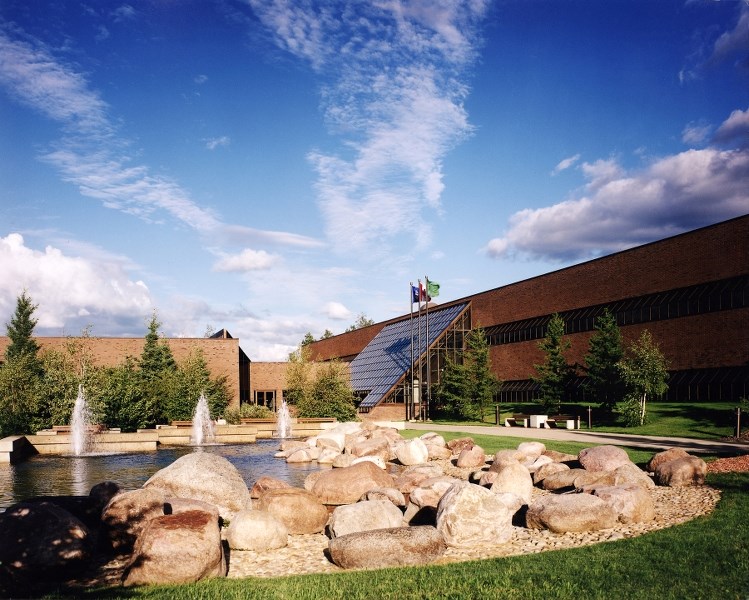Athabasca University (AU) will be unable to pay its debt in two years if immediate action is not taken, according to a sustainability report released June 1.
The report was conducted by the AU Sustainability Taskforce and proposed four options AU could take in order to remain a sustainable and open university.
After months of input and deliberation, the taskforce concluded AU would face insolvency on its debt in two years, despite a $3.6 million surplus in the 2013-2014 budget and another $2 million in 2014-2015.
“Our problem is a common one — our expenses are going up faster than our revenues," said AU interim president Peter MacKinnon. "We haven't come to conclusions that A, B and C must be done. What we were directed to do is prepare options.
“We've tried to analyze the sources of our sustainability issues and set out four options. And others may suggest other options to us in the course of discussions. It's a report intended to generate analysis, discussion, debate."
The taskforce was created back in March to gather input from administration, staff and faculty members, and develop options for AU to tackle its looming financial crisis.
MacKinnon said AU’s financial troubles stemmed from several sources, including increased reliance on tuition and decreased government funding to cover operating expenses, caps on tuition that limit AU revenue, the location of AU and demands from employee collective agreements.
He declined to elaborate on collective agreements but said the fact it was mentioned at all has been a source of criticism.
Information Technology was highlighted as another serious sustainability issue because the provincial education budgets did not consider it a capital expense.
"It's mission critical capital, and we need to make some more major investments in it," he noted. "When your doing online education — this is an open university — most of our students don't live in a physical location here. Our capacity to reach them and teach them is not dependent on classrooms and buildings but on our information technology and our people.
“The information technology has to be excellent and provide our platforms to reach our students all over the world."
The Taskforce received 136 submissions, much of which focused on greater efficiency and effectiveness in both course delivery and business practices. Some proposals suggested IT outsourcing, charging for online services to other institutions.
The submissions also brought up issues with human resources and the impact of scattered campuses and workforces on communication and productivity.
Among the four options in the report, the one guaranteed to be implemented emphasized cost-effectiveness and streamlining business, administrative and education practices.
Under the Campus Alberta framework of accessibility, sustainability and excellence, the next option would focus on “greater efficiency and effectiveness in both course delivery and business practices,” the report said.
“I think it’s required,” MacKinnon stated. “That, to me, has to be done regardless of the options.”
Business practices will be audited immediately, followed by an education review or inventory by faculties with advice from General Faculties Council.
Another option on the table would refocus AU’s mission to serve only, or primarily, students who physically reside in Alberta, in addition to a potential leadership role in eCampus Alberta.
However, the report noted the university could suffer from a decline in enrolment, reduced funding, staff and program cuts. AU’s reputation would also suffer for changing its mandate of openness and accessibility to one of exclusivity. If this were to move forward, it would be in conjunction with the first option.
The two related options proposed AU become a federation with another Alberta post-secondary institution or join an affiliation with universities both in and out of the province.
“A federation is a formal relationship between two institutions,” MacKinnon explained. “It's probably a closer relation than an affiliation. Inevitably, each participant would say there's some things we need to do together. Is it giving up an institution's autonomy? No.”
The AU Taskforce considered merging with another Alberta post-secondary institution if both see an advantage and “they can do together what they can’t do separately, and they can do it better,” the report stated. However, transition funding would be required from the provincial government, and possibly legislation.
Because AU already has campuses in Edmonton, potential partners would be Edmonton-based institutions.
On the other hand, an affiliation would work with other universities to achieve academic or shared goals that benefit on another.
For example, Canadian Virtual University is an association of Canadian universities that specialize in online and distance education.
MacKinnon stated that AU has been engaging in a number of austerity measures including staff reductions, but that it won't last forever since there's only so much to reduce.
He added that none of the options are mutually exclusive, so the outcome may be a combination, depending on consultations with the provincial government and stakeholders.
The Taskforce will present its report to Minister of Alberta Innovation and Advanced Education (AIAE) Lori Sigurdson who will then work with AU to decide on an option.
A date has not been determined.



